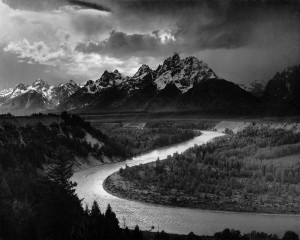Ansel Adams helped create what we now call American wilderness through his skillful photography – both his photographs and the places he used them to protect are national treasures. Recently, many of us were reminded of our country’s wilderness legacy through celebrations of the 50th anniversary of the Wilderness Act. For a quick reminder, the Act designated some of our federally-held lands as wilderness:
For this purpose there is hereby established a National Wilderness Preservation System to be composed of federally owned areas designated by Congress as “wilderness areas”, and these shall be administered for the use and enjoyment of the American people in such manner as will leave them unimpaired for future use as wilderness, and so as to provide for the protection of these areas, the preservation of their wilderness character, and for the gathering and dissemination of information regarding their use and enjoyment as wilderness.

Yet, along with this celebrated history, these recent discussions have also provoked a number of managers to utilize this strong piece of legislation to their political advantage – and dare I say, without keeping in the spirit of the law.
The US Forest Service, which includes wilderness among its working forests, is proposing to require members of the press to get a $1,500 permit for shooting photographs and videos in their wilderness areas. Don’t get the permit, and it’s $1,000 fine. It’s not clear who counts as press, either. Sure, if you write for the New York Times, but what about blog authors or people with twitter feeds? That’s why some claim this proposal is entirely unenforceable.
What’s at stake here is a matter of free press (guaranteed by the First Amendment) as well as access and use of our treasured public lands. Liz Close, the Forest Service’s acting wilderness director, could not come up with an example situation in which permitting would help them. But $1500 is prohibitively expensive – especially for journalists who walk the environmental beat – and Close also hinted that only positive stories would be allowed to receive a permit.
The legal framework for this permit system hinges on the restriction of commercial activities by the Wilderness Act:
Except as specifically provided for in this Act, and subject to existing private rights, there shall be no commercial enterprise and no permanent road within any wilderness area designated by this Act and, except as necessary to meet minimum requirements for the administration of the area for the purpose of this Act (including measures required in emergencies involving the health and safety of persons within the area), there shall be no temporary road, no use of motor vehicles, motorized equipment or motorboats, no landing of aircraft, no other form of mechanical transport, and no structure or installation within any such area.
Interestingly, this same clause is what forms the foundation of the case for kicking Drakes Bay Oyster Farm out of Point Reyes National Seashore. Read more from the oyster farm’s legal team and their community organizing and you quickly realize that its a similar issue: wilderness is not – as much as we like to say it is – entirely natural. We, as humans, decided that “pristine wilderness” does not include humans at all, even if they were historically part of the landscape. And creating those wilderness areas took years of careful negotiation, planning, and management that is ongoing.
While an oyster farm does leave a noticeable (although arguably positive) impact in an estuary, the forest service’s restrictions on photography cannot include that side of the argument. Plus, there’s a freedom-of-the-press angle that shouldn’t be taken lightly. But I keep returning to the history of wilderness in this country and the powerful role that photographers played. Photographers can bring wilderness, which is often hard to get to, into our living rooms and our morning commutes. Our wilderness areas need more press, not less, if we want to teach our future generations about one of our country’s biggest legacies.
If you care about this issue, please submit public comment to the Forest Service. Your voice matters.